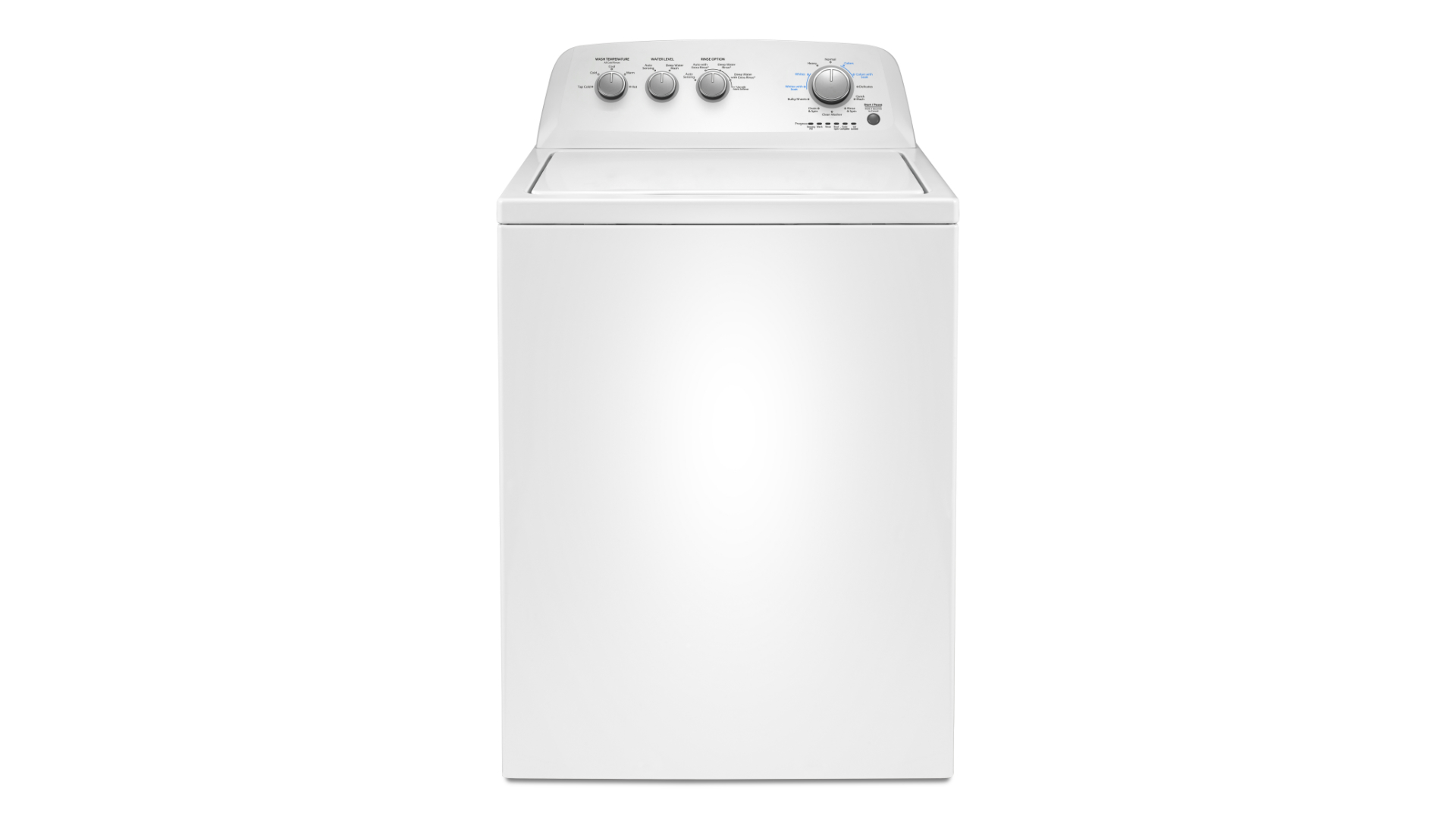
Whirlpool has been making washing machines for over 100 years. Their range of models features top-loaders, front-loaders, and washer-dryer combinations. Occasionally, even the highest quality models may have an issue with the spin cycle. The most common causes of the issue can be fixed by following this guide.
This guide applies to the following Whirlpool washer models:
2LA5700XMW0
2LA5700XMW1
2LSR5233BN0
2LSR5233BQ1
2LSR5233BW0
2LSR5233BZ1
LSC8244EQ0
LSC8244EQ1
LSC8244EZ0
LSC8244EZ1
LSR6132EQ0
LSR6132EZ0
LSR7233EQ0
LSR7233EW0
LSR7233EZ0
LSR8233EQ0
LSR8233EZ0
LSR8244EQ0
LSR8244EQ1
LSR8244EZ0
LSR8244EZ1
The Basics
On a top-loader washer, clothes need to be placed evenly around the agitator. If there is an imbalance, perhaps because clothes have gotten caught up on one side of the drum, the motion of the washer is disrupted, which results in a subpar spin cycle. For the same reasons, the washer itself also needs to be balanced. If your washer is on a lean and not level, this will affect the spin cycle.
A water blockage, perhaps caused by a kinked external hose, can also cause the washer to stop emptying and spinning. Check to see it is not a water drainage issue that is stopping the washer from spinning.
Lid Switch (Top-Loader Washers)
The most common reason a Whirlpool top-loader washer stops spinning is a faulty lid switch. The lid switch is a safety measure that prevents the washer from spinning while the lid is open. The lid switch on most top-loader washers can be activated manually using a screwdriver or pencil to push it to simulate the lid being closed. You should also be able to hear the lid switch click when you close the lid. If you cannot, it probably needs to be replaced.
Follow these steps to check and replace the lid switch:
- Unplug the washer from the power source.
- Locate the two screws holding the lid switch in place (usually in the top right corner where the lid would close).
- Use a Phillips-head screwdriver (most models) to remove the two screws that hold the lid switch in place. On other models, the top control panel may have to be removed to access the lid switch. If you are still unable to access the lid switch, the washer’s entire cabinet may need to be taken off.
- Once you remove the screws holding the lid switch in place, you should be able to pull the lid switch out from between the washer drum and top washing machine panel. On other models, the lid switch may still be attached due to wiring that will need to be disconnected.
- Use a multimeter to test the lid switch for continuity.
- If there is no continuity, replace the lid switch with a new one.
Door Lock (Front-Loader Washers)
Like the lid switch on top-loader washers, if the door lock on front-loader washers is faulty, the washer will not spin. The door lock can be checked for a mechanical fault by inspecting it closely and paying attention to it as you open and close the door. To see if the door lock is faulty due to an electrical fault, you will need to test it with a multimeter. If the door lock is broken, it is likely unrepairable and will need to be replaced.
Follow these steps to check and replace the door lock:
- Unplug the washer from the power source.
- To access the door lock, the boot needs to be pulled back. The boot is held in place by a metal ring clamp with a spring. Use a flathead screwdriver to reach underneath the door seal to remove the tension and lift it off.
- Once the ring clamp is removed, pull back the boot so that you can access the door lock.
- Remove the screws holding the door lock assembly in place.
- The door lock assembly sits on a mounting bracket. Reach inside the washer and carefully lift the door lock assembly off the mounting bracket.
- Disconnect the wires attached to the door lock assembly, and remove it from the washer. Some models may have a shield over the connectors that can be removed by popping it out with a flathead screwdriver.
- Test the door lock with a multimeter. If it is defective, replace the door lock.
On some models, removing the top panel of the washer may provide easier access to replace the door lock.
Drive Belt
Another common reason for a washer not spinning is a problem with the drive belt. The drive belt is responsible for rotating the tub. Over time, the drive belt can become loose or break, which causes the washer not to spin.
Follow these steps to inspect and fix the drive belt:
- Unplug the washer from the power source.
- Turn off the water supply to the washer and disconnect the hoses to provide easier access to the rear washer panel.
- Remove the back panel of the washer.
- Check that the drive belt is secure and not damaged.
- If you decide to replace the drive belt, turn the tub drive pulley, and the belt should fall off.
- To install a new drive belt, put one end of the new belt around the motor pulley and place the other end on the tub drive pulley. Rotate the tub drive pulley to secure the new drive belt.
- With the new drive belt fitted, reassemble the washer.
Motor Coupling
A broken motor coupling is another common cause of a washer not spinning. The motor coupling attaches the motor to the transmission. It is made up of two white plastic coupler parts and a rubber isolator piece that fits between them.
Normal wear and tear or an overloaded washer can cause the motor coupling to break. If the motor coupling breaks, the washer will not spin.
When repairing the motor coupling, it is recommended that you do not remove the clutch, as this can be difficult to put back after the brake disengages.
Follow these steps to repair the motor coupling:
- Disconnect the washer from the power source.
- Turn off the water, and if necessary, disconnect the external hose to gain access to the rear of the washer.
- On a top-loader washer, you will need to remove the screws on the control panel and lift it up to access the retaining clips that hold the washer frame on. Then remove the washer frame. On a front-loader washer, you may need to remove the top panel to gain access to the back panel, which needs to be removed.
- To access the motor, the pump will need to be removed. Unclip the retainer clips and pull the pump off the motor shaft.
- Disconnect the motor wiring harness.
- Remove the two screws that hold the motor retainer clips in place. Be careful, as the motor is heavy.
- Inspect the motor coupler for damage.
- To replace the motor coupler, remove the old motor coupler parts.
- Install the new motor coupler.
- Reassemble the washing machine.
Less Common Causes
A Whirlpool washer not spinning may also be due to a problem with the clutch, timer, water level control, or stator assembly (front-loader washers).

Your Guide to Whirlpool Microwave Replacement Parts

What to Do When Your Kenmore Dryer Won’t Start

How to Resolve the LG Washer LE Error Code

Why Does My Oven Smell Like Gas? Causes and What to Do

Maytag Dryer Not Heating? Here’s How to Fix It

6 Common Reasons Your Speed Queen Dryer Isn’t Heating

8 Reasons Your Samsung Refrigerator Is Not Cooling

9 Most Reliable Washer and Dryer Brands

How to Get Ink out of Your Dryer the Easy Way

Why Is My Fridge Making Noise That Stops When the Door Is Open?

Frigidaire Refrigerator Error Code H1: Causes & Solutions

How to Clean a Dryer Vent Without Moving the Dryer

9 Reasons Your LG Refrigerator Isn’t Cooling

LG Refrigerator Not Making Ice? Here’s What To Do!


